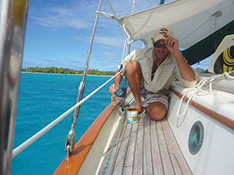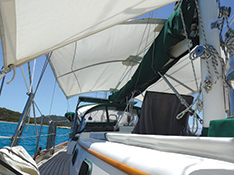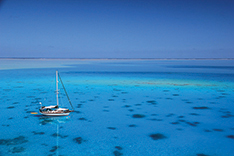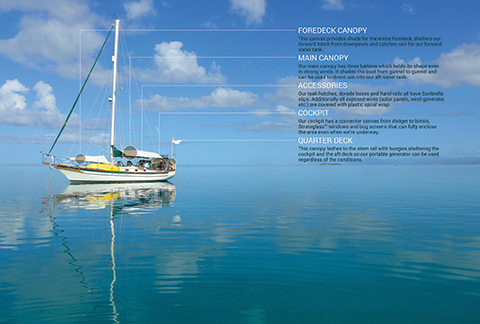A cruising couple benefit from a little shade (published Dec/Jan 2016-17)
We admire intrepid cruisers, captains and crew intent on sailing high latitudes, enduring chilly challenges around distant windswept capes. But my wife, Catherine, and I have little interest in exploring regions that require anything more than board shorts and bikinis. Shimmering lagoons, remote coral atolls, uninhabited sandy isles—we seek the tropics, the warm, quiet, sundrenched corners of our planet, and since we left New York to sail around the world we’ve spent the majority of our time happily bobbing between latitudes 10 and 22 degrees in the South Pacific.
Typically long-term cruising boats that enjoy warmer climes can be easily spotted by the sheer square footage of canvas draped over them. During New York summers we rarely saw or needed anything more than a bimini for cockpit shade, but when we sailed south to the Florida Keys in 2007, and then deeper into the Caribbean in 2008, sheltering in Guatemala for hurricane season, we experienced, for the first time, the full and relentless searing heat of the tropics, and we felt completely exposed. But now, after 30,000 nautical miles of sunny sailing, Dream Time, our 1981 Cabo Rico, once bare and unprotected with nary a shady accessory, sports a full complement of canopies.
We take pride in our boat, but we’re not the kind to wipe early morning dew off varnish work to save the finish. She’s a cruising vessel, a little scarred, salty and fully lived in. We rarely frequent marinas, so she only gets a fresh water rinse when it rains, stainless work is seldom stainless, and exterior teak is coated in Cetol rather than glossy varnish. But over nine years of blue water sailing, we’ve learned the value, comfort and convenience of a few strategically placed covers.
We have canopies over the entire foredeck, the quarter deck, a fully battened canopy above the boom, and a variety of cockpit canvas and accessories to zip-in and shield us from sun, spray, rain or mosquitoes. But we don’t want to live in a canvas cave, we enjoy being outside, so over the years they’ve been adjusted in size, position and color to give us the best combination of protection and freedom.
But they do more than provide just a little shade to shelter teak, cool the cabin and protect crew. Our canopies (all made with Sunbrella) are sacrificial covers, our first line of defense against tropical wear and tear. They’re easy and inexpensive to repair, durable, and can remain rigged even when trades are blowing at twenty knots. But more importantly, they keep our more expensive sail covers, cushions, dodger and deck hardware almost fully protected from UV damage. They’re also practical in other areas; serving as rain catchers, funneling water right into our tanks; they provide shelter so hatches can remain open even during tropical downpours, allowing fresh air to flow through the cabin; and they enable us to make full use of our deck space.
 But one of the most enjoyable benefits of our shelter is lounging in our hammock, swinging in the shade under our main canopy, which is rigged over our boom from mast to topping lift. It’s an idyllic spot to read, nap or just soak-up the view, and the best part, as we’re fully protected from the sun, clothing is optional.
But one of the most enjoyable benefits of our shelter is lounging in our hammock, swinging in the shade under our main canopy, which is rigged over our boom from mast to topping lift. It’s an idyllic spot to read, nap or just soak-up the view, and the best part, as we’re fully protected from the sun, clothing is optional.
So if you’re heading to the tropics this cruising season and don’t want to feel completely exposed, take along more than just a few bottles of SPF 50, consider covering some of your boat, too. A little protection from the elements can feel surprisingly liberating.
 Read about the cruising experiences of Neville and Catherine Hockley on their website: www.zeroXTE.com.
Read about the cruising experiences of Neville and Catherine Hockley on their website: www.zeroXTE.com.















